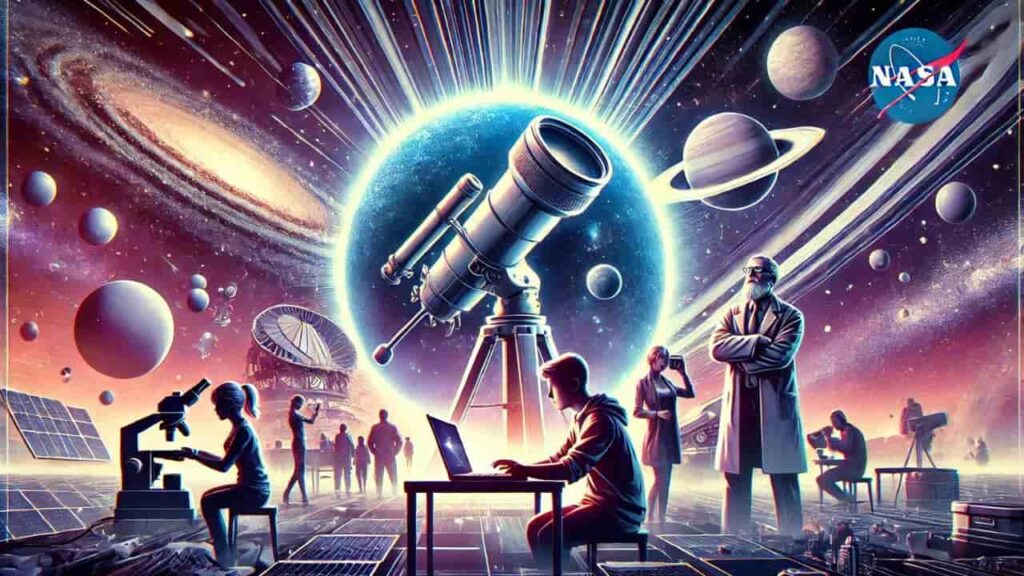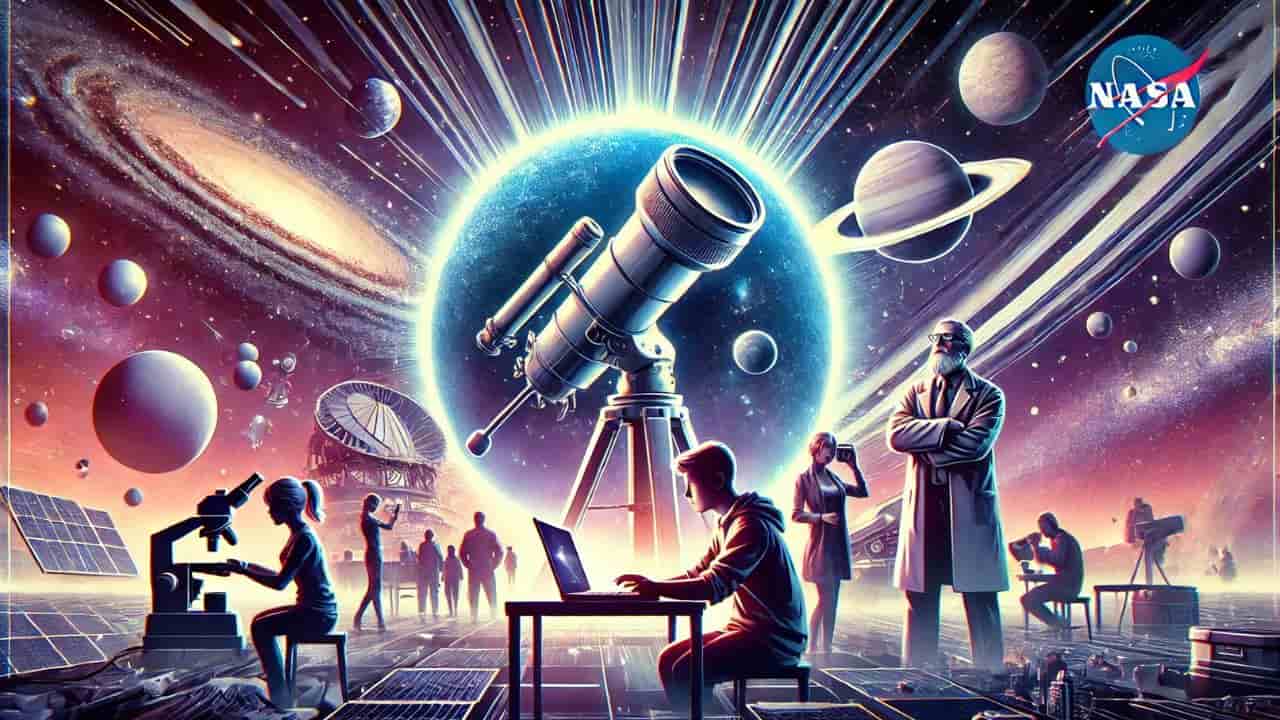Discover how NASA’s citizen science programs are revolutionizing exoplanet research, allowing anyone to contribute to groundbreaking discoveries with the upcoming Nancy Grace Roman Space Telescope and Habitable Worlds Observatory.
NASA citizen science, exoplanet research, Nancy Grace Roman Space Telescope, Habitable Worlds Observatory, exoplanets, TESS mission, Kepler mission, space exploration, public science initiatives, artificial intelligence in astronomy

How NASA Citizen Science Fuels Future Exoplanet Research
NASA’s upcoming flagship missions, the Nancy Grace Roman Space Telescope and the Habitable Worlds Observatory, are set to revolutionize the study of exoplanets — planets that exist outside our solar system. These missions are part of a broader initiative to explore the cosmos, with a particular focus on finding and studying these distant worlds. What makes these missions especially exciting is not just the advanced technology they bring, but the role that everyday people, known as citizen scientists, will play in the discovery and study of exoplanets.
To date, over 5,000 exoplanets have been confirmed by scientists, and this number is expected to rise significantly. Given that researchers estimate there is at least one exoplanet for every star in the sky, the search for these distant worlds is still in its early stages. NASA’s new missions, Roman and the Habitable Worlds Observatory, will build on the legacy of previous missions like Kepler and TESS, continuing the search for exoplanets. However, what sets these missions apart is the unprecedented level of public involvement they invite.
The Legacy of Citizen Science in Exoplanet Research
Citizen science has long been a part of NASA’s exoplanet research. The Kepler mission, which launched in 2009, and the TESS mission, which followed in 2018, have both made their data available to the public, allowing anyone with an interest to contribute to the discovery of new exoplanets. This open science policy has not only democratized the search for exoplanets but has also led to significant discoveries made by non-professional astronomers.
One of the most notable examples of this is the Planet Hunters TESS project, where members of the public can classify exoplanet light curves — graphs that show how the light from a star changes over time — online. This project has already led to the discovery of new planets and continues to be a valuable resource for scientists. Another initiative, Exoplanet Watch, allows citizen scientists to gather data about known exoplanets and submit their observations to NASA’s public data archive. What’s more, participants don’t need their own telescopes; Exoplanet Watch curates data from robotic telescopes that users can process, making the project accessible to anyone with a smartphone or laptop.
Rob Zellem, the project lead and project scientist for Exoplanet Watch, emphasized the importance of these citizen science efforts. “Anyone across the world who has access to a smartphone or a laptop can fully participate in a lot of these citizen science efforts to help us learn more about the cosmos,” Zellem said. This level of accessibility has led to significant contributions from citizen scientists, who have helped discover new planets and refine observation strategies, saving valuable time on flagship missions like NASA’s James Webb Space Telescope.
The Promise of Roman and the Habitable Worlds Observatory
The upcoming Nancy Grace Roman Space Telescope, expected to launch by May 2027, and the Habitable Worlds Observatory, which will follow, promise to take citizen science to the next level. Roman will discover exoplanets through various methods, including direct imaging, transits, and gravitational microlensing. The Habitable Worlds Observatory will go even further, taking direct images of stars in our solar neighborhood to find potentially habitable planets and study their atmospheres.
What makes these missions particularly exciting for citizen scientists is the open access to data. Just like with Kepler and TESS, data from Roman and the Habitable Worlds Observatory will be available to the public immediately after processing. This means that citizen scientists will have the same access to data as professional researchers, allowing them to contribute to new discoveries in real-time.
Roman is expected to deliver a terabyte of data to Earth every day, over 17 times as much as the James Webb Space Telescope. This vast amount of data presents a huge opportunity for the public to help sift through the information, identifying potential exoplanets and other astronomical phenomena. As Zellem noted, “The general public can get Roman data as quickly as I can as a scientist working on the mission. It truly makes Roman a mission for everyone and anyone.”
The Habitable Worlds Observatory is also expected to embrace citizen science. Although the mission’s full capabilities and instrumentation have yet to be finalized, the team is already taking a community-oriented approach. Working groups for the mission are open to volunteers from around the world, allowing anyone with an interest to contribute to the planning process. Megan Ansdell, the program scientist for the mission, highlighted the importance of this approach: “It’s already setting the tone for open science with the Habitable Worlds Observatory. The process is as open as possible, and these working groups are open to anybody in the world who wants to join.” Over 1,000 community working group members are already participating, including several citizen scientists.
The Role of Artificial Intelligence and the Future of Citizen Science
As the amount of data generated by missions like Roman and the Habitable Worlds Observatory continues to grow, there is an increasing need for tools to help process and analyze this information. One promising avenue is the use of artificial intelligence (AI) in combination with citizen science. AI can be incredibly powerful in terms of classification and identifying anomalous phenomena. However, human insight is still crucial for evaluating what those anomalies might be.
Joshua Pepper, the deputy program scientist for the Habitable Worlds Observatory, sees a significant role for citizen scientists in this area. “AI can be exceptionally powerful in terms of classification and identifying anomalous things,” Pepper said. “But the evaluation of what those anomalous things are often requires human insight, intervention, and review, and I think that could be a really fantastic area for citizen scientists to participate.”
Before the launch of Roman and the Habitable Worlds Observatory, there is still plenty of data to analyze from previous missions like Kepler and TESS. However, the contributions of citizen scientists will become even more important as data from the new missions begin to pour in. As Zellem said, “We’re in a golden age of exoplanet science right now.” The involvement of citizen scientists in this golden age ensures that the search for exoplanets is not just in the hands of professional astronomers but is a collective effort that includes contributions from people all over the world.
How to Get Involved in NASA’s Citizen Science Projects
NASA’s citizen science projects are open to anyone with an interest in contributing to scientific research. These projects do not require U.S. citizenship, and participants from all over the world have already made significant contributions. Whether you’re interested in classifying exoplanet light curves, analyzing data from robotic telescopes, or contributing to the planning of future missions, there are plenty of opportunities to get involved.
To find a project that interests you, visit NASA’s Citizen Science page. Here, you can explore a wide range of projects and find one that fits your interests and skills. By participating in these projects, you can help fuel the future of exoplanet research and be a part of NASA’s ongoing efforts to explore the cosmos.
In conclusion, NASA’s citizen science initiatives are an essential part of the agency’s exoplanet research. These projects not only democratize the search for exoplanets but also enable significant contributions from the public. As new missions like the Nancy Grace Roman Space Telescope and the Habitable Worlds Observatory prepare to launch, the role of citizen scientists will only become more important. With the vast amounts of data these missions will generate, the collective efforts of professional astronomers and citizen scientists alike will be crucial in the search for new worlds.
Read More
- NASA and Sierra Space Dream Chaser Arrives in Florida for Launch Prep
- NASA Webb Telescope Hints at Possible Atmosphere Surrounding Rocky Exoplanet
- NASA’s Select Terrain Vehicle for Artemis Missions
- NASA Considers SpaceX Rescue for Stranded Boeing Starliner Crew A Major Setback for Boeing










